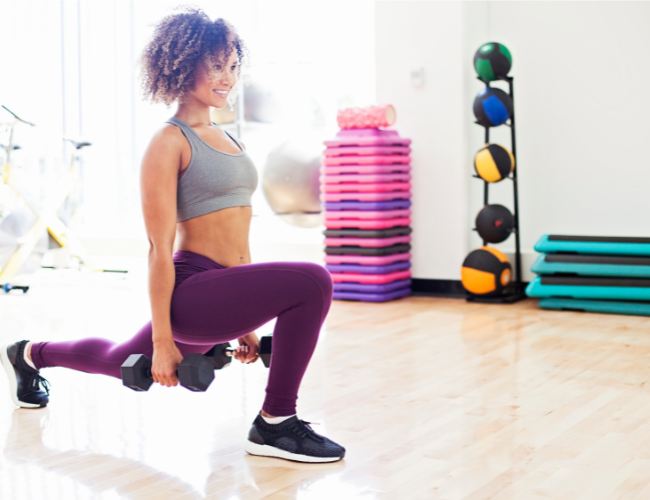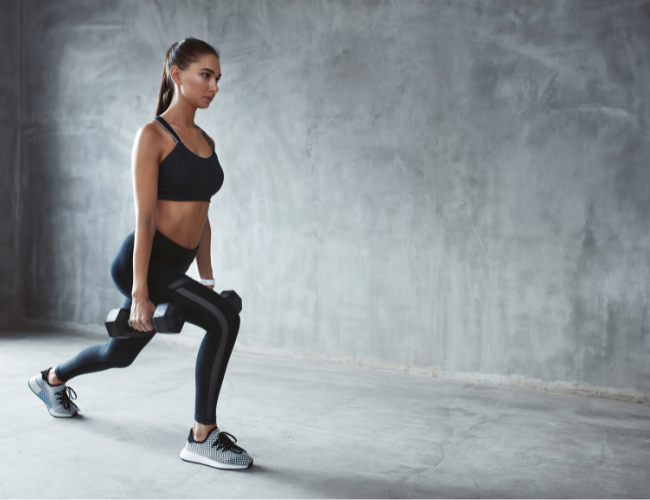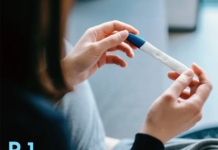If you could name an exercise that focuses on multiple muscles in the lower body as well as builds stability and core strength, what would your answer be?

You may first think of the squat or the deadlift, but an even better answer is the lunge — an important compound exercise that doesn’t get the hype it deserves.
Did you know that when you kneel, walk, or run, you’re performing a variation of a lunge? By taking a lunging step forward, you work the muscles in your hips, glutes, and hamstrings, improving your strength, balance, and flexibility. The movement also translates to a variety of sports, including running and cycling.
“The lunge pattern is the everyday cure to imbalance,” says Miami-based NASM-certified personal trainer Marielis Martinez. That’s because compared to other classic strength exercises like squats or deadlifts, lunges require both sides of your body to work independently while maintaining balance and stability in the upper body.
And when you add dynamic movement to the lunge — in this case, we’re talking about walking lunges — it only increases the challenge and benefits.
You may have seen people doing walking lunges across your gym, or been asked to do them during a HIIT class. The truth is, walking lunges are worth incorporating into your routine in addition to the stationary lunges you may already know and love.
If striding across your weight room feels intimidating, or you’re worried about how walking lunges will feel on your knees, don’t worry.
We have everything you need to know about the move, including the benefits of walking lunges, muscles worked, how to adjust the exercise to different fitness levels, and step-by-step instructions to perform them safely.
Walking Lunges: Benefits and Muscles Worked
In general, walking lunges are a highly functional lower-body strength exercise since they closely mimic the movement pattern used for walking and stair climbing, according to the National Strength and Conditioning Association (NSCA).
Practicing walking lunges regularly can help make these everyday movements easier. Even better? They can be performed anywhere and without any equipment.
Which muscles are worked by walking lunges? A forward lunge primarily works the glutes, hamstrings, quadriceps, and calves, according to the NSCA. Research shows that forward lunges or walking lunges also target the glutes much more than stationary lunges (aka split squats).
Lunges get your core involved, too, as your ab muscles work to stabilize your torso while you’re balancing in a split-stance position.
Because you’re transferring all your weight from one foot to another and asking each leg to stabilize while you move, walking lunges can also help with balance, coordination, and control, according to the the UC Davis Human Performance Lab.
When you do a lunge, you’re actually lengthening multiple muscles (especially the hips, hamstrings, and glutes), whether you realize it or not.
This means that while strengthening your lower body with walking lunges, you’re also working to improve your range of motion.
If you do walking lunges across your living room or gym floor, you’ll notice your heart start pumping harder — likely much more than when you’re doing stationary lunges.
Because walking lunges are a dynamic movement, your heart rate increases, adding a cardio element. This means that doing walking lunges regularly can even contribute to cardiovascular health.
How to Do Walking Lunges

Here’s how to perform walking lunges with proper form, according to Martinez.
- Start standing with your feet shoulder-width apart and your hands by your sides, on your hips, or clasped in front of your chest.
- Take a big step forward with your right foot, putting the weight into your heel.
- Bend the right knee, lowering down so that your right thigh is parallel to the floor (or as low as is comfortable for you) and your rear knee is hovering just off the floor.
- (Ideally, both knees and and your right hip should be bent at 90-degree angles.) Pause for a second.
- Push off your back leg and transfer all your weight into your front foot to come to stand on the right leg.
- Tap your left foot to the floor or (for a more advanced variation) hover your left foot off the floor and immediately take a big step forward with that leg to repeat the move on the other side.
- Repeat this movement, “walking” forward as you lunge, alternating legs.
Walking Lunge Form Tips
As you try walking lunges, keep the following form tips in mind:
- Make sure your front knee stays in line with your toes and doesn’t cave in or out.
- Your rear knee doesn’t need to touch the ground, it just needs to hover.
- Keep your core engaged with each step, and try not to lean forward.
- If you’re a beginner, try walking lunges first with just your bodyweight, then work your way up to holding a dumbbell in each hand.
- If you find yourself wobbling, try taking smaller steps. Think about stepping forward with your feet at hips-width distance; don’t step each foot forward in a line, as if walking on a tightrope.
Walking Lunge Variations and Modifications
If you find that walking lunges are too difficult, try to build up your strength with stationary lunges first, as recommended by the NSCA.
You can also decrease your range of motion if lowering all the way down is causing pain or is uncomfortable; even a small range of motion will activate the muscles used by walking lunges, challenge balance, and help increase functionality, per the NSCA.
If walking lunges are easy for you, you can also increase your level of intensity with your walking lunge by adding a few variables that will keep you on your toes.
Overhead Walking Lunge: Grab a weight plate (5-10 pounds) and hold it above your head. Keep your core engaged and your arms straight overhead, biceps by your ears.

Perform the walking lunge holding the weight overhead. This version of weighted walking lunges will challenge your core strength and your shoulder stability. Try to keep the plate from moving forward while executing the move.
Dumbbell Walking Lunge: If you want to advance your walking lunge and really burn out your legs at the same time, this is the perfect exercise. (It makes a great addition to a leg-day workout.)

Perform with a weight that makes you feel challenged and balanced while walking. Hold a dumbbell in each hand by your sides and follow the same instructions above for a regular walking lunge.
Alternating Forward Lunge: If you don’t have the space to walk, you can perform both exercises above by alternating forward lunges at a fast pace.

Alternating forward lunges are great for elevating your heart rate and maintaining the dynamic component of the walking lunge.



















